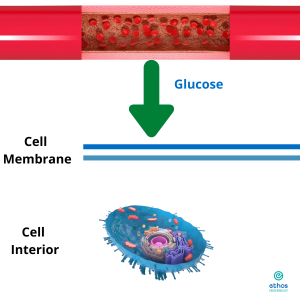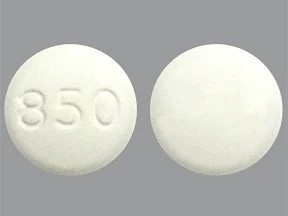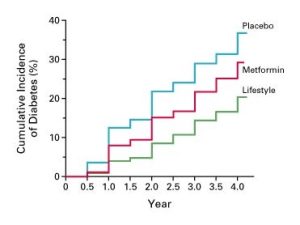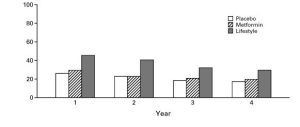Reversing Prediabetes: What You Need to Know
Can you reverse prediabetes? How do you reverse prediabetes naturally? As an endocrinologist and obesity medicine specialist, I am asked these questions often.
Is there scientific evidence for this? We want proof that prediabetes can be reversed in a sizable population of people.
In a landmark study called the Diabetes Prevention Program (DPP), a percentage of people reversed prediabetes through lifestyle changes or the diabetes medication, Metformin.
Let’s discuss prediabetes, the DPP, and the 2 ways prediabetes was reversed in the DPP.
What is prediabetes?
Prediabetes refers to blood sugar (plasma glucose) levels that are higher than normal but do not meet the criteria for diabetes. According to the American Diabetes Association (ADA), prediabetes is diagnosed with one of the three the following criteria:
Fasting Plasma Glucose: 100 mg/dL-125 mg/dL
OR
2-hour Plasma Glucose during 75-gram Oral Glucose Tolerance Test (OGTT): 140 mg/dL-199 mg/dL
OR
Hemoglobin A1c: 5.7%-6.4%
For reference, an oral glucose tolerance test is one method of detecting prediabetes, diabetes mellitus, and gestational diabetes. It is first performed by checking a fasting glucose by drawing blood. Then the individual drinks a beverage with 75 grams of sugar. Then, glucose levels are checked by drawing blood 1 and 2 hours after the drink is finished.
What are the symptoms of prediabetes?
Prediabetes usually presents with no symptoms. Despite the lack of symptoms, prediabetes is associated with an increased risk for developing diabetes and cardiovascular disease, such as heart disease.
Prediabetes can remain unrecognized for years. Prompt diagnosis and treatment is necessary to prevent the progression to diabetes and reduce the risk of cardiovascular disease.
Why are blood sugar levels higher in prediabetes?
A 2006 study conducted at the Mayo Clinic examined 32 men and women with prediabetes and 28 men and women with normal blood sugar levels. Each person’s blood sugar and insulin levels were checked after eating a meal and a 75-gram oral glucose tolerance test on separate occasions.
As a group, blood sugar increased to higher levels in people with prediabetes compared to people with normal blood sugar levels. The higher levels of blood sugar in people with prediabetes were because of a lower rate of blood sugar being taken up by the body’s cells. This simple illustration may help:

Glucose (blood sugar) filters from small blood vessels. The glucose needs to get through the outer layer, called the cell membrane, into the inside of the cell. Insulin allows glucose through the cell membrane into the cell. If insulin’s action is not as effective in allowing glucose into the cell, the glucose builds up in the blood. In other words, a higher blood sugar level.
The Diabetes Prevention Program (DPP)
The DPP was a clinical trial conducted at 27 centers around the United States from 1996 to 2001. The study included 3,234 individuals with prediabetes (but not diabetes).
Characteristics of the participants include:
- Average age: 50.6 years
- 67.7% Female; 32.3% Male
- 54.7% Caucasian
- 45.3% African American, Hispanic, American Indian, and Asian
- Average Body Mass Index (BMI) 34
- Average Hemoglobin A1c 5.9%
The 3,234 participants were randomly assigned into 1 of 3 groups:
- Standard lifestyle recommendations plus Metformin at a dose of 850 mg twice daily
- Standard lifestyle recommendations plus a placebo pill twice daily
- Intensive program of lifestyle modification
For group 1, Metformin was started at a dose of 850 mg daily. At 1 month, Metformin was increased to 850 mg twice daily, unless gastrointestinal side effects delayed the increase.

Standard lifestyle recommendations for the Metformin and placebo groups included:
- Follow the Food Guide Pyramid
- Reduce weight
- Increase physical activity
Participants in both groups received recommendations in written form and an annual 20-to-30 minute individual session.
The intensive program of lifestyle modification included a goal weight loss of 7% of initial body weight by following a low-calorie, low-fat diet and physical activity of moderate intensity, such as brisk walking, for at least 150 minutes per week. People in this group were given a 16-lesson curriculum to help achieve this goal.
Participants were followed for an average of 2.8 years. Let’s look at the results by asking specific questions.
What was the chance of developing type 2 diabetes?
The estimated number of new cases of diabetes at the 3 year mark was 28.9% in the placebo group, 21.7% in the Metformin group, and 14.4% in the intensive lifestyle program group.

How much did participants lower their chance of developing type 2 diabetes?
Participants in the intensive lifestyle program group lowered their chance of developing type 2 diabetes by 58% compared to placebo.
Participants in the Metformin group lowered their chance of developing type 2 diabetes by 31% compared to placebo.
What percentage of participants reversed prediabetes at 1 year?
We will define “reverse prediabetes” as a normal fasting glucose and a normal glucose at the 2-hour mark of the oral glucose tolerance test. The graph below shows the percentage of participants in each group who achieved a normal glucose by both criteria, i.e. reverse prediabetes.

Approximately 25% of participants in the placebo group reversed prediabetes with standard lifestyle changes at the 1 year mark. About 30% in the Metformin group and over 40% in the intensive lifestyle group achieved a reversal of prediabetes.
We expect the number of participants reversing prediabetes to decrease with each passing year. Most remarkable is the effectiveness of the intensive lifestyle group. About 30% of people in this group maintained normal blood sugar values when extrapolated to the 4 year mark.
Metformin remained modestly more effective than placebo in maintaining normal blood sugar values when estimated out to 4 years.
Final Thoughts
We have proof that prediabetes can be reversed in a population of people through intensive lifestyle changes or Metformin. Of those who didn’t reverse prediabetes, a significant number lowered their chance of developing type 2 diabetes.
Diagnosing prediabetes is the first step. Develop a personalized plan with your primary care physician or endocrinologist to reverse prediabetes or prevent the progression to diabetes. Ultimately, reducing your risk of cardiovascular disease.
Schedule an initial consultation to discuss how we can create a personalized plan for you. If you have comments or questions about prediabetes, share them in the comments section.
Related Questions
Can I reverse prediabetes with diet and exercise?
Yes! The Diabetes Prevention Program showed us that an intensive lifestyle program, comprising a low-calorie, low-fat diet and 150 minutes per week of moderate-intensity physical activity, can reverse prediabetes (normalize blood sugars).
How can I get rid of prediabetes fast?
The most effective method, as shown by the Diabetes Prevention Program, is an intensive lifestyle program with a goal weight loss of 7% of initial body weight. At the 1-year mark, over 40% of participants in the intensive lifestyle group achieved a normal fasting blood sugar and a normal blood sugar at the 2-hour mark of the oral glucose tolerance test.
What are the warning signs of prediabetes?
Prediabetes usually presents with no symptoms or warning signs. Despite the lack of symptoms and signs, prediabetes is associated with an increased risk for developing diabetes and cardiovascular disease, such as heart disease.
Prediabetes can remain unrecognized for years. Diagnosing prediabetes is the first step. Develop a personalized plan with your primary care physician or endocrinologist to potentially reverse prediabetes or prevent the progression to diabetes.





